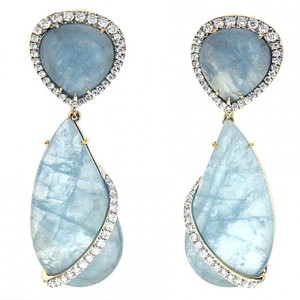Aquamarine Color – Blue
“A Sea-faring Gem” – Aquamarine is a member of the beryl mineral family, its pale blue color tinted with green inspired its name, taken from the Greek word for sea water. This jewel is always a pastel hue, but deeper saturations are regarded as much more valuable. Aquamarines are durable gemstones and are appropriate for all types of jewelry.
Introduction to Aquamarines
 Aquamarines are the light blue birthstone of March. Like its cousin the emerald, aquamarines are a type of beryl, but colored with iron rather than chromium or vanadium. Beryl forms within gaps in the earth’s crust, where mineral rich water containing specific elements gradually forms into a crystal. The resulting stones may be enormous, weighing as much as 110 kilos. Aquamarine is usually found amongst granite, filling in gaps left behind by geological activity.
Aquamarines are the light blue birthstone of March. Like its cousin the emerald, aquamarines are a type of beryl, but colored with iron rather than chromium or vanadium. Beryl forms within gaps in the earth’s crust, where mineral rich water containing specific elements gradually forms into a crystal. The resulting stones may be enormous, weighing as much as 110 kilos. Aquamarine is usually found amongst granite, filling in gaps left behind by geological activity.
Gem quality aquamarine are found in many countries, including Afghanistan, Brazil, Canada, Myanmar, Madagascar and the United States. Brazil is birthplace of many notable stones, including the 10,363 carat Dom Pedro aquamarine and the 1,298 carat Roosevelt’s aquamarine. Brazil also produces an unusually blue form of the jewel with deeper saturation and fewer greenish shades known as Maxixe aquamarine or blue beryl.
When shopping for aquamarine, most people aim for one that is eye clean, or has no visible clarity characteristics. These type of jewels are usually fashioned into ovals, rounds and emerald cuts, though larger stones are favored for fantasy cuts. Those with visible clarity characteristics are usually carved into beads, cabochons or fanciful shapes such as shells before they are mounted into jewelry. Some characteristics may be desirable, depending on the nature of the inclusion and the skill of the cutter, such as a cat’s eye cabochon. In terms of color, medium tone saturated blue with a slight green tinge is the most popular.
Famous Aquamarines
Named after the first emperor of Brazil, the Dom Pedro is a 14-inch-long fantasy cut jewel carved by artist Bernd Munsteiner. Its outline is an obelisk while its reverse side contains a series of concave facets which form a line of eight sunbursts. The design took four months to plan, while faceting was a six-month process. The Dom Pedro was unveiled in Switzerland in 1993, and placed on permanent display in the Smithsonian in 2012.
In 1936, President and First Lady Franklin D. and Eleanor Roosevelt were visiting South America.
When they stopped in Rio De Janeiro, Brazilian President Vargas gave the First Lady a massive aquamarine as a good luck charm. Ms. Roosevelt later wrote how she felt the aquamarine stood for Brazilian good will towards the United States. The jewel is a deep greenish blue with dark tone, fashioned into an emerald cut. The stone remains unmounted and in its original satin lined box. The aquamarine resides in the Franklin D. Roosevelt Presidential Library and Museum of Hyde Park, New York, where it is sometimes placed on display.
Aquamarine Lore
Aquamarine’s name come from the Latin words for “ocean” and “water,” referencing the color of the gemstone. Ancient Greeks and Romans used the jewel to safeguard themselves from harm while at sea. It was also a tradition to carve the image of Poseidon onto aquamarines as to create a talisman of courage. Not only did Poseidon stones give Greeks and Romans the bravery to face the perils of the ocean, it also gave aquamarines a long lasting legend. As late as 1936, the jewel was used as a sign of safe passage at sea.
Other legends celebrate aquamarine’s and other beryl’s social powers. Dreaming of aquamarines meant that new friends were in the future, while wearing the stone made a person wittier, personable and hard working. If a woman wore an aquamarine, she’d become happily married. Carving a frog onto the jewel strengthened friendships, settled arguments and helped its wearer gain peace with enemies. Aquamarine could even give its wearer an upper hand with legal issues.
In the early 1900s, spiritualism was popular. Crystal balls were one of the many tools used to gain insight into the unknown, but not any material would do. Orbs of different shapes and substances were used to accomplish specific goals. Cubes of aquamarine and other blue beryl were considered best for seeing angels.





